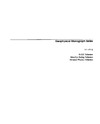Published by the American Geophysical Union as part of the Geophysical Monograph Series.
As we become a space-faring culture, there is an increasing need for reliable methods to forecast the dynamics of electromagnetic fields, thermal plasma, and energetic particles in the geospace environment, as all these factors affect satellite-borne systems. From the electrodynamics viewpoint, on the other hand, the inner magnetosphere is a key element in the Sun-Earth connection chain of processes. Most notably, it is a region where a significant part of the storm-time energy input from the solar wind is deposited and dissipated.
Because the most interesting and crucially important phenomena, as noted, develop relatively close to Earth (in the transition region separating the innermost quasi-dipolar geomagnetic field from the magnetotail), understanding them is a complex task. Moreover, the stronger the disturbance, the deeper its impact penetrates into the inner magneto-sphere. In this region plasma no longer behaves like a fluid, and the motion of energetic charged particles becomes important for the dynamics of the system. This fact leaves “particle simulations” as a primary tool for studying and understanding the dynamics of the inner magnetosphere during storms. An integral element of such simulations is an electromagnetic field model. Recent studies of the inner magnetosphere have substantially improved our understanding of its dynamics while creating new paradigms and reviving old controversies.
Content:
 |
|
О проекте
|
|
О проекте


